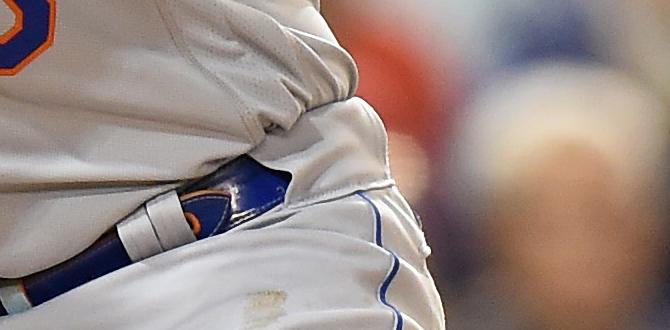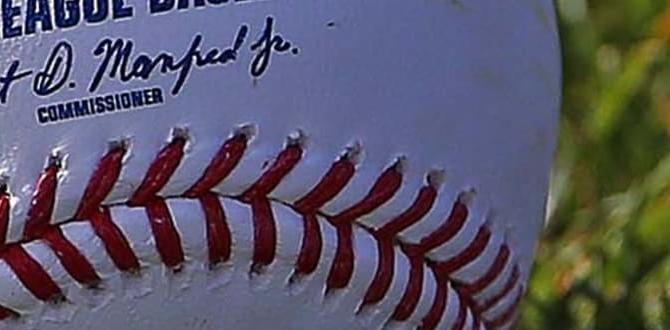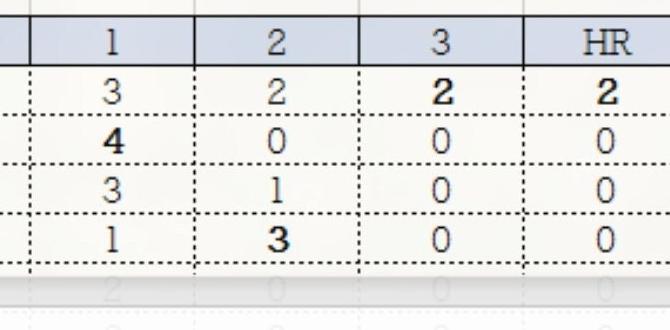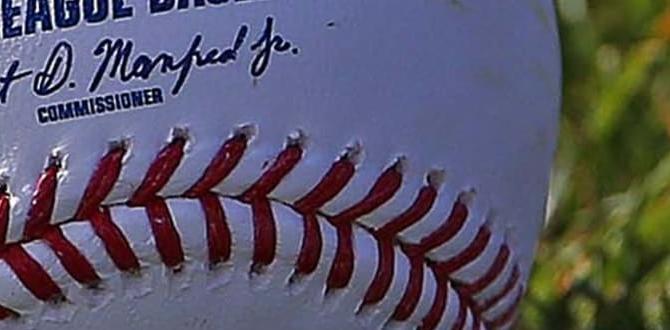Have you ever watched a baseball game and wondered what W.A.R. means? It’s a term you might hear often, yet not everyone knows its importance. W.A.R. stands for Wins Above Replacement. This term helps us understand how valuable a player is to their team.
Imagine a situation where your favorite player is injured. Will their team struggle without them? W.A.R. can help answer that question. It compares players and shows how much better one player is than a replacement. The higher the W.A.R., the more valuable that player is!
Here’s a fun fact: Some players have sky-high W.A.R. scores, while others may not contribute as much. This scoring drives debates among fans and experts alike. Curious about how it works and why it matters? Keep reading to dive deeper into the world of baseball statistics and discover all about W.A.R.!
What Does W A R Stand For In Baseball? Understanding Its Meaning

What Does WAR Stand for in Baseball?
WAR stands for “Wins Above Replacement.” It is a key statistic used in baseball to measure a player’s total value. A player with a high WAR contributes significantly more wins to their team than a replacement-level player. Curious about how it’s calculated? It considers batting, fielding, and pitching performance. For example, if a player has a WAR of 5, they helped their team win five more games than an average substitute would. Isn’t that fascinating?History of WAR in Baseball Analytics
Origins of the WAR statistic and its development over time. Key figures and organizations that contributed to its evolution.WAR, or Wins Above Replacement, began as a way to capture a player’s overall value. It helps teams see how much better a player is than a substitute. This idea first emerged in the early 2000s, thanks to people like Bill James and Sean Smith. They wanted to create a single number to sum up a player’s performance. Over time, various groups like Baseball Prospectus and FanGraphs contributed ideas, refining the formula to make it more accurate.
What does WAR measure in baseball?
WAR measures how many more wins a player contributes compared to a replacement player. It considers hitting, pitching, and fielding to show a player’s total value.
Key Contributors:
- Bill James: Pioneered modern baseball statistics.
- Sean Smith: Developed early WAR models.
- Baseball Prospectus: Improved statistical analysis.
- FanGraphs: Popularized WAR in baseball discussions.
How WAR is Calculated
Breakdown of the components used to calculate WAR (batting, fielding, and pitching). Discussion on the different formulas used by various baseball analysts (e.g., FanGraphs vs. BaseballReference).WAR stands for Wins Above Replacement. This statistic shows how valuable a player is. To calculate it, analysts look at different parts of a player’s skills, such as:
- Batting – How well does the player hit?
- Fielding – How well does the player catch and throw?
- Pitching – How effectively does the player throw to batters?
Each analyst might have different methods. For example, FanGraphs and BaseballReference use unique formulas. This can lead to different WAR numbers for the same player. Baseball fans love these details, as they help to see who the real stars are.
What is the difference between FanGraphs WAR and Baseball Reference WAR?
FanGraphs WAR focuses more on offensive stats, while Baseball Reference WAR includes defensive stats more heavily.
Understanding the Different Types of WAR
Explanation of position player WAR vs. pitcher WAR. Insights on the importance of park factors and league adjustments.Baseball fans love to debate about players, and WAR helps us compare them. For position players, WAR focuses on hitting, fielding, and running. Meanwhile, for pitchers, it measures how well they prevent runs. Isn’t that smart? Also, park factors play a role, too. Some stadiums are easier to hit homers. It’s like playing dodgeball in a bouncy castle! That’s why we adjust for league differences. It’s all about fairness in the game!
| Type of WAR | Focus |
|---|---|
| Position Player WAR | Hitting, fielding, and running |
| Pitcher WAR | Preventing runs |
The Impact of WAR on Player Evaluation and Team Strategy
How teams use WAR in decisionmaking (trades, contracts, and player development). Comparison of WAR to traditional statistics in measuring player value.Many teams now use WAR, or Wins Above Replacement, to guide their choices. This number helps teams decide who to trade, sign, or develop. Imagine a head coach figuring out what player fits best, like picking a pizza topping. It’s serious business! Traditional stats are like counting apples, while WAR is more like measuring how tasty the pie is overall. Here’s a quick look:
| Stat Type | What It Measures |
|---|---|
| Traditional Stats | Single Player Performance |
| WAR | Player Value Compared to Replacement |
This helps teams understand not just numbers, but player impact, like who can knock the ball out of the park or trip over their own shoelaces! So, when teams talk WAR, they’re not debating a game of chess; they’re strategizing to win the championship!
Common Misconceptions about WAR
Addressing myths and misunderstandings regarding WAR’s reliability and limitations. Clarifying the context in which WAR should be interpreted.Many think WAR is a magic number that tells us everything about a player’s skill. But oh boy, it’s not that simple! WAR has its ups and downs. It can be helpful, yet it shouldn’t be the only tool in your baseball toolbox. Imagine trying to fix a bike with only a hammer! WAR’s context matters. Some players shine in different ways and can’t be measured perfectly by numbers. So, before we throw WAR around like a baseball, let’s remember it has its limits too!
| Misperceptions | Truth |
|---|---|
| WAR is always accurate | It has limitations and should be used with caution. |
| All players have the same WAR value | Different contexts affect their skills! |
| WAR tells the whole story | It’s just one piece of a much bigger puzzle. |
The Future of WAR in Baseball Analytics
Emerging trends and technologies that may influence WAR calculations. Predictions on the evolution and relevance of WAR in the future of baseball statistics.Baseball is changing fast, and so is the way we look at stats like WAR. New gadgets and tech are making players’ performances easier to measure, turning the game into a science project. Player tracking systems and better data analysis tools will make WAR calculations more precise. In the future, expect WAR to evolve and stay important, even if we have to rethink what those numbers mean. Who knows? Maybe one day, we’ll calculate WAR for hot dog eating skills too!
| Trend | Description |
|---|---|
| Player Tracking | Real-time data on player movements and actions will enhance predictions. |
| AI Analysis | Artificial intelligence may help analyze big data faster than ever. |
| Wearable Tech | New gadgets will give insights on player health and performance. |
Conclusion
In baseball, W.A.R. stands for Wins Above Replacement. It helps us measure a player’s value. A higher W.A.R. means a better player who contributes more wins for their team. Understanding W.A.R. can deepen your appreciation for the game. You can explore more about player statistics and their impact next time you watch a game!FAQs
What Does The Acronym War Represent In The Context Of Baseball Statistics?WAR stands for Wins Above Replacement. It tells us how many more games a player helps their team win compared to a player who is just okay. If a player has a high WAR, it means they are really valuable. We can use WAR to compare different players’ performances. It helps us see who is the best!
How Is War Calculated For A Player, And What Factors Are Considered In Its Formula?WAR stands for Wins Above Replacement. We use it to see how much a player helps their team win. To calculate WAR, we look at the player’s hitting, pitching, and fielding skills. We also consider how much they play compared to a typical player. By combining these numbers, we can see how many more games the player helps their team win.
What Are The Primary Differences Between Position Player War And Pitcher War In Baseball?Position player WAR (Wins Above Replacement) and pitcher WAR are both ways to measure how good a player is. Position player WAR looks at how well players like shortstops or outfielders hit and field the ball. It counts things like runs scored and defensive plays. Pitcher WAR, on the other hand, measures how good pitchers are at getting batters out and stopping runs. So, they focus on different skills needed in the game.
How Does War Help Teams And Analysts Evaluate A Player’S Overall Contribution To Their Team?WAR stands for Wins Above Replacement. It tells us how many wins a player adds to their team compared to a backup player. If a player has a high WAR, it means they are really good and help their team win more games. Coaches and analysts use WAR to decide which players are the best for the team. This helps them make smart choices about trades and game strategies.
Can A Player’S War Value Vary Significantly From One Season To Another, And What Factors Might Influence These Changes?Yes, a player’s WAR, which means Wins Above Replacement, can change a lot from one season to another. If a player gets hurt, they might not play as well or as much. Changes in their teammates or the team’s coach can also affect how they perform. Even their training or how well they practice can make a big difference in their game.








